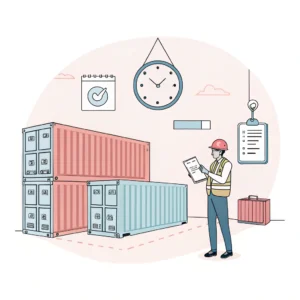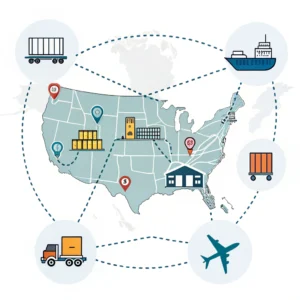Delivered At Place (DAP) is a critical Incoterm1 for international buyers and freight forwarders to understand. Simply put, under DAP, the seller delivers the goods to a named place in the buyer’s country, ready for unloading, and the buyer assumes responsibility thereafter. This means the seller bears the costs and risks up to the arrival at the agreed destination, but the buyer handles unloading, import customs clearance2, and local duties.
For international buyers seeking to optimize freight forwarding operations, mastering DAP terms is essential to clarify cost allocation, risk transfer, and shipment process responsibilities. This guide provides a practical, in-depth overview of DAP Incoterms for buyers, helping you negotiate better deals with suppliers and collaborate effectively with freight forwarders.
DAP (Delivered At Place) is one of the 11 Incoterms 2020 rules defined by the International Chamber of Commerce3. It specifies that the seller delivers when the goods are placed at the disposal of the buyer on the arriving means of transport, ready for unloading at the named destination (which could be a warehouse, terminal, or other location).
Key points about DAP include:
- Seller bears all risks and costs until arrival at the agreed place, including export duties, carriage, and main transport.
- Buyer is responsible for unloading, import customs clearance, and payment of import duties or taxes.
- Delivery occurs before unloading, unlike in Delivered Duty Paid (DDP), where the seller also clears customs and pays duties.
- Risk transfers from seller to buyer once goods arrive at the destination point ready for unloading.
This term is highly flexible and suitable for buyers wanting control of import and customs formalities while avoiding the hassle of managing inland transportation from the seller’s side.
To fully understand practical implications, it helps to break down each party’s obligations.
| Responsibility | Seller Obligations | Buyer Obligations |
|---|---|---|
| Export Formalities | Obtain export licenses, clear customs at origin | None |
| Pre-carriage Transport (to port/airport) | Arrange and pay | None |
| Main Carriage (ocean/air/road) | Arrange and pay | None |
| Transport to Named Place | Transport goods to agreed delivery point | None |
| Unloading at Destination | Not responsible; goods delivered ready for unloading | Responsible for unloading costs and risks |
| Import Customs Clearance | Not responsible | Handle customs clearance, pay import duties/taxes |
| Risk Transfer Point | When goods are ready for unloading at named place | From unloading onwards |
| Proof of Delivery | Provide delivery confirmation to buyer | Confirm receipt |
This division means buyers must plan and budget for unloading, import clearance, and local distribution after arrival. Sellers carry all risks during export packing, inland transport, and main conveyance.
For buyers coordinating global shipments, misunderstanding DAP terms can create costly logistics inefficiencies:
- Unexpected unloading costs: Buyers unprepared for unloading responsibility risk unexpected fees or delayed delivery.
- Customs clearance delays: If buyers don’t arrange timely customs clearance, goods can be held at the destination.
- Risk of damages during unloading: Since risk transfers before unloading, buyers should ensure proper handling or insurance coverage at the delivery point.
- Misallocation of freight costs: Clarifying cost responsibilities upfront prevents disputes with sellers and freight forwarders.
A freight forwarder familiar with DAP terms can help buyers with:
- Coordinating inland customs brokerage and clearance.
- Organizing unloading at destination.
- Providing insurance advice for arrival-to-unloading risks.
- Managing efficient scheduling to avoid warehouse demurrage.
By mastering these logistics details and clarifying terms, buyers streamline their supply chain and reduce lead times and costs.
| Challenge | Explanation | Recommended Solution |
|---|---|---|
| Import customs clearance delays | Buyer slow or unprepared for customs formalities | Partner with expert customs brokers4, prepare docs early |
| Unclear unloading responsibility | Miscommunication on who pays unloading fees | Clearly specify unloading terms in contracts and work with freight forwarder |
| Risk coverage gap at destination | Damage during unloading after risk transfer | Purchase additional cargo insurance covering unloading phase |
| Freight cost misunderstanding | Dispute over freight and handling cost split | Ensure freight cost allocation is explicitly stated in sales contract |
| Delivery place ambiguity | Undefined delivery points leading to delays or extra charges | Confirm exact named place and access details with seller and freight forwarder |
An electronics buyer in Germany imported products from China using DAP terms. The seller managed all export packing, inland transportation, and ocean freight to the German port.
The buyer arranged:
- Import customs clearance through their appointed broker.
- Unloading at the port warehouse and onward delivery to their facility.
Because responsibilities were clearly defined:
- The seller bore all risks during transport.
- The buyer properly budgeted for import duties and unloading fees.
- Delivery happened smoothly without demurrage or customs delays.
This case underscores how buyers gain control over import processes but must plan ahead for local handling and customs obligations.
- Specify the exact delivery place: Provide clear addresses and unloading instructions to avoid access issues.
- Confirm cost and risk allocation in writing: Avoid ambiguity on who pays for unloading, customs duties, and extra warehousing.
- Work with a reliable freight forwarder: Choose partners experienced with DAP shipments who can advise on customs compliance and local transport.
- Arrange cargo insurance: Ensure coverage includes the delivery point and unloading phase since risk transfers before unloading.
- Prepare import paperwork in advance: Collaborate with customs brokers to avoid clearance delays.
- Communicate regularly with sellers and forwarders: Transparency reduces misunderstandings and expedites delivery.
- Understand alternate Incoterms1: Evaluate if other terms like DDP or FOB better suit your logistics preferences.
Delivered At Place (DAP) terms place the logistics burden of transport and export on the seller but require buyers to manage unloading, import clearance, and related costs. For buyers, this means greater control but also increased responsibility at the destination.
To leverage DAP effectively:
- Be clear about delivery locations and responsibilities with suppliers.
- Collaborate with experienced freight forwarders and customs brokers4.
- Prepare budgets for unloading and customs duties.
- Insure goods against risk after arrival.
- Monitor shipment progress to avoid delays.
By understanding DAP terms thoroughly, international buyers can optimize their shipping operations, reduce delays and disputes, and improve overall supply chain efficiency.
What are the buyer's obligations in DAP?
Under DAP, the buyer is responsible for unloading goods at the named place, arranging and paying for import customs clearance, and covering any import duties or taxes. The buyer must also manage risks related to the unloading process and provide proof of delivery acceptance.
Who pays freight on DAP terms?
The seller pays for all carriage costs, including packing, export formalities, main transport, and delivery to the buyer’s named place. The buyer pays for unloading, import clearance, and any import duties. Risk transfers to the buyer once the goods reach the agreed destination ready for unloading.
What are DAP terms in logistics?
DAP means Delivered At Place, where the seller bears all costs and risks involved in delivering the goods to an agreed location, excluding unloading and import formalities which are the buyer’s responsibility. It is commonly used when buyers want to handle import customs themselves.
-
Incoterm: Read this to understand the standardized international trade terms published by the International Chamber of Commerce that define responsibilities and risks between seller and buyer.
↩︎ Back to Incoterm ↩ ↩2 -
Customs clearance: This article explains procedures required for goods to enter a country legally, including documentation and payment of tariffs and taxes, essential for importers to know.
↩︎ Back to customs clearance ↩ -
International Chamber of Commerce: Learn about the global organization that establishes rules like Incoterms to facilitate international trade and commerce.
↩︎ Back to International Chamber of Commerce ↩ -
Customs brokers: Explore the role of licensed professionals who assist importers and exporters with customs regulations, documentation, and compliance to ensure smooth import/export processes.
↩︎ Back to customs brokers ↩ ↩2












